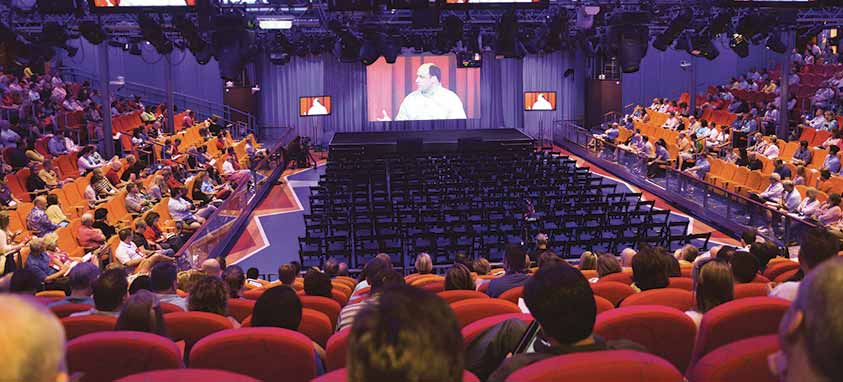Cruise passengers aboard Royal Caribbean’s Oasis of the Seas ship participate in a viewing (Photo courtesy of Royal Caribbean International)
Great tools are available for planners on a strict budget
In fact, according to American Express Meetings & Events surveys conducted in August 2016, there is only a 3 percent chance that the AV allotment of a meeting budget would be the first thing on the chopping block in North America. This is not consistent worldwide, however. In Europe, it dips down to an average of 2 percent. Asia comes in at 5 percent. Australia, at 13 percent, is more likely than anywhere else to snip the AV budget.
Psychology Behind AV
The reason for the priority is simple. AV contributes to the ability to hold an audience captive. Planners want to draw the entire audience in and give the last row a front row seat.
“Educational research suggests that approximately 83 percent of human learning occurs visually [and] 11 percent auditorily,” states a report published by BrainStrength Systems and PSAV in 2011. “When information is presented orally through a speaker talking, studies reveal that individuals remember about 10 percent of it when tested three days later. This figure goes up to 65 percent when visual imagery is added.”
AV can be a powerful learning tool to tap into multiple senses. The skillful execution of AV can help planners achieve the end goal of the entire audience absorbing the information presented.
“In meetings, multisensory cues can help individuals perceive and retain information,” the report says. “The artful combination of audio and visual stimuli can draw attention to specific stimuli, help reduce noise within the perceptual system and provide a broad context for meaning that aids in learning.”
Preventing and Preparing for Tech Issues
Technology can be our best friend and at times our worst enemy. Planners need to hope for the best and prepare for the worst. A prime example is the blackout at Super Bowl XLVII in New Orleans’ Superdome. An investigation revealed that a faulty relay device caused the outage.
What can be learned from this major flub to prevent it from happening at your event? No matter how much testing and rehearsal is done in preparation, nothing is foolproof or a guarantee when it comes to technology. Always have a Plan B, such as backup generators or alternative power sources. Make sure your power grid can sustain the amount of electricity the event will be consuming.
Venues Investing in AV
Before signing a contract to hold an event at a hotel, read the fine print, particularly the AV clause, very closely, advises blogger Katie McKown, general manager of Sparksight, a production company based in Austin, Texas. Hotels often charge a much higher fee than outside vendors to provide AV services. They encourage you to use in-house services so they earn a commission.
Planners should make sure they have the freedom to hire a third-party vendor. According to Meeting Tomorrow, a nationwide AV service and rental company, event coordinators can save as much as 64 percent on AV by hiring a third-party vendor.
Consider setting sail on the high seas for your next event. AV can be quite costly at a hotel on the mainland, but cruise ships offer it complimentary. Royal Caribbean International’s entire fleet provides event spaces that can accommodate meetings with just a few attendees to those with more than 1,000. The ships come equipped with access to professional-grade lighting and sound technology, high-speed internet, microphones, video walls, wall-mount screens and everything else your event planning heart desires—all for free.
“Royal Caribbean is the leader when it comes to offering the largest dedicated conference centers in the industry on all 25 ships,” says Lori Cassidy, associate vice president of global corporate, incentive and charter sales for Royal Caribbean International. “There is a significant cost savings to planners when operating an event at sea. This is just one of the many reasons why more and more planners are considering a cruise for their next meeting, incentive or event.”
Things to Consider
- Take into account unique challenges such as proximity to the airport, fire station, construction, the direction of sun.
- Notify presenters what will be provided by the event for them to use and what they need to bring on their own. Set up a designated area to test equipment and technology before taking the stage.
- Consider the advantages of an inside versus an outside event.




